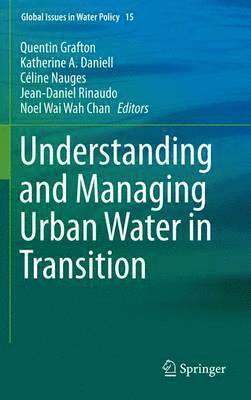
- Format
- Inbunden (Hardback)
- Språk
- Engelska
- Antal sidor
- 641
- Utgivningsdatum
- 2015-05-19
- Upplaga
- 2015 ed.
- Förlag
- Springer
- Medarbetare
- Grafton, Quentin (ed.), daniell, Katherine A. (ed.), Nauges, Céline (ed.), Rinaudo, Jean-Daniel (ed.), Chan, Noel Wai Wah (ed.)
- Illustratör/Fotograf
- 30 schwarz-weiße Tabellen 30 schwarz-weiße und 20 farbige Abbildungen Bibliographie
- Illustrationer
- 54 Illustrations, color; 37 Illustrations, black and white; XI, 641 p. 91 illus., 54 illus. in color
- Dimensioner
- 234 x 156 x 35 mm
- Vikt
- Antal komponenter
- 1
- Komponenter
- 1 Hardback
- ISBN
- 9789401798006
- 1090 g
Understanding and Managing Urban Water in Transition
- Skickas från oss inom 7-10 vardagar.
- Fri frakt över 249 kr för privatkunder i Sverige.
Passar bra ihop
De som köpt den här boken har ofta också köpt Slow Productivity av Cal Newport (häftad).
Köp båda 2 för 1695 krKundrecensioner
Fler böcker av författarna
-
The Economics of the Environment and Natural Resources
Quentin Grafton, Wiktor Adamowicz, Diane Dupont, Harry Nelson, Robert J Hill
-
Economics of the Environment and Natural Resources
Quentin Grafton, Wiktor Adamowicz, Diane Dupont, Harry Nelson, Robert J Hill
-
Co-Engineering and Participatory Water Management
Katherine A Daniell
-
Multi-level Governance: Conceptual challenges and case studies from Australia
Katherine A Daniell, Adrian Kay
Innehållsförteckning
Chapter 1 Understanding and managing urban water in transition (introduction).- Part 1 Water supply and sanitation.- Chapter 2 How water services manage territories and technologies: history and current trends in developed countries.- Chapter 3 Coping with extraneous water in sewerage systems.- Chapter 4 Challenges for water supply and sanitation in developing countries: case studies from Zimbabwe.- Chapter 5 The challenges of providing water and sanitation to urban slum settlements in South Africa.- Chapter 6 Integrating water quality into urban water management and planning while addressing the challenge of water security.- Chapter 7 The development of private bore-wells as independent water supplies: challenges for water utilities in France and Australia.- Chapter 8 Inter-basin transfers as a supply option: the end of an era?.- Chapter 9 Three engineering paradigms in the historical development of water services: more, better and cheaper water to European cities.- Chapter 10 Investing in the water infrastructure of tomorrow.- Part 2 Water demand and water economics.- Chapter 11 Long-term water demand forecasting.- Chapter 12 The use of non-pricing instruments to manage residential water demand: What have we learned?.- Chapter 13 The Social determinants of water consumption in Australian cities.- Chapter 14 Non-household Water Demand: the Industrial and Commercial Sectors.- Chapter 15 Integrating social aspects into urban water pricing: Australian and international perspectives.- Chapter 16 Does residential water use depend on water quality? Some answers from a French case study.- Chapter 17 A simulation model for understanding the consequences of alternative water and wastewater tariff structures: A case study of Fayoum, Egypt.- Chapter 18 Managing water variability issues.- Chapter 19 Volumetric Water Pricing, Social Surplus and Supply Augmentation.- Part 3 Water governance and integrated management.- Chapter 20 Governance and regulation of the urbanwater sector: Quoi de neuf?.- Chapter 21 Publicprivate partnerships and their ownership in the urban water sector.- Chapter 22 Issues of governance, policy and law in managing urbanrural and groundwatersurface water connections.- Chapter 23 Integrated management of urban water supply and water quality in developing Pacific Island countries.- Chapter 24 The renaturation of urban rivers: the case of the St Charles River in Quebec.- Chapter 25 Adapting to climate change in urban water management: flood management in the RotterdamRijnmond area.- Chapter 26 Transboundary urban water: the case of Singapore and Malaysia.- Chapter 27 The opportunities and challenges of implementing water sensitive urban design: lessons from stormwater management in Victoria, Australia.- Chapter 28 How does energy efficiency affect urban water systems?.


